Organizational Behavior: Group Dynamics Case Study Report
VerifiedAdded on 2023/06/09
|6
|1518
|144
Report
AI Summary
This report delves into the realm of organizational behavior, using a case study of a homemade food company to illustrate the impact of group dynamics on performance. The report identifies group cohesion as a key factor affecting productivity, where employees' close relationships lead to extended breaks and early departures, thereby hindering work output. It then explores how Mr. Lim, the production manager, can improve performance using the effective model, focusing on context, composition, and process. The report emphasizes the importance of performance evaluation, reward systems, and team size optimization. It concludes by highlighting the need to balance group cohesion with productivity goals, encouraging wise decision-making to foster a positive work environment and ensure the achievement of organizational objectives.
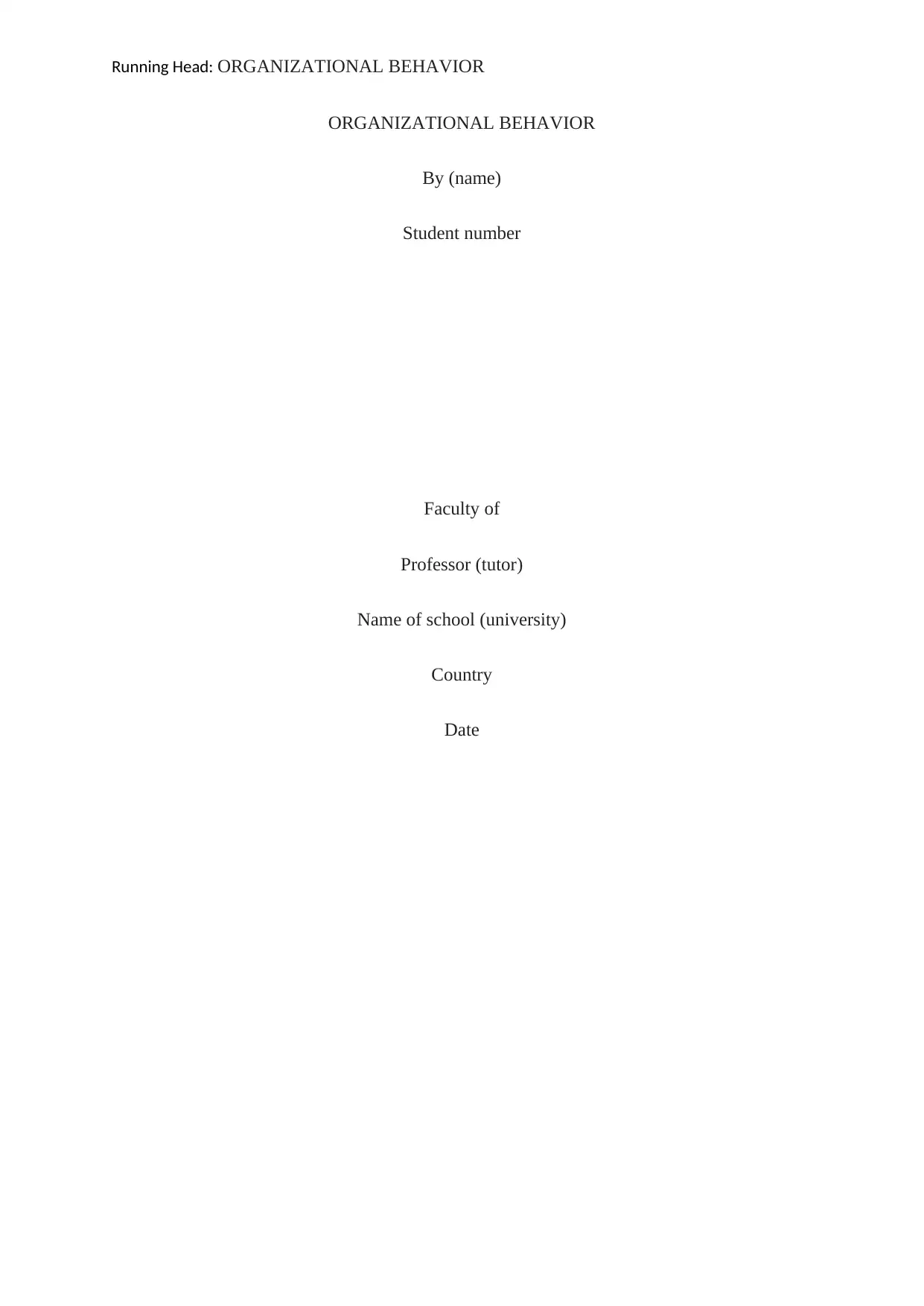
Running Head: ORGANIZATIONAL BEHAVIOR
ORGANIZATIONAL BEHAVIOR
By (name)
Student number
Faculty of
Professor (tutor)
Name of school (university)
Country
Date
ORGANIZATIONAL BEHAVIOR
By (name)
Student number
Faculty of
Professor (tutor)
Name of school (university)
Country
Date
Paraphrase This Document
Need a fresh take? Get an instant paraphrase of this document with our AI Paraphraser
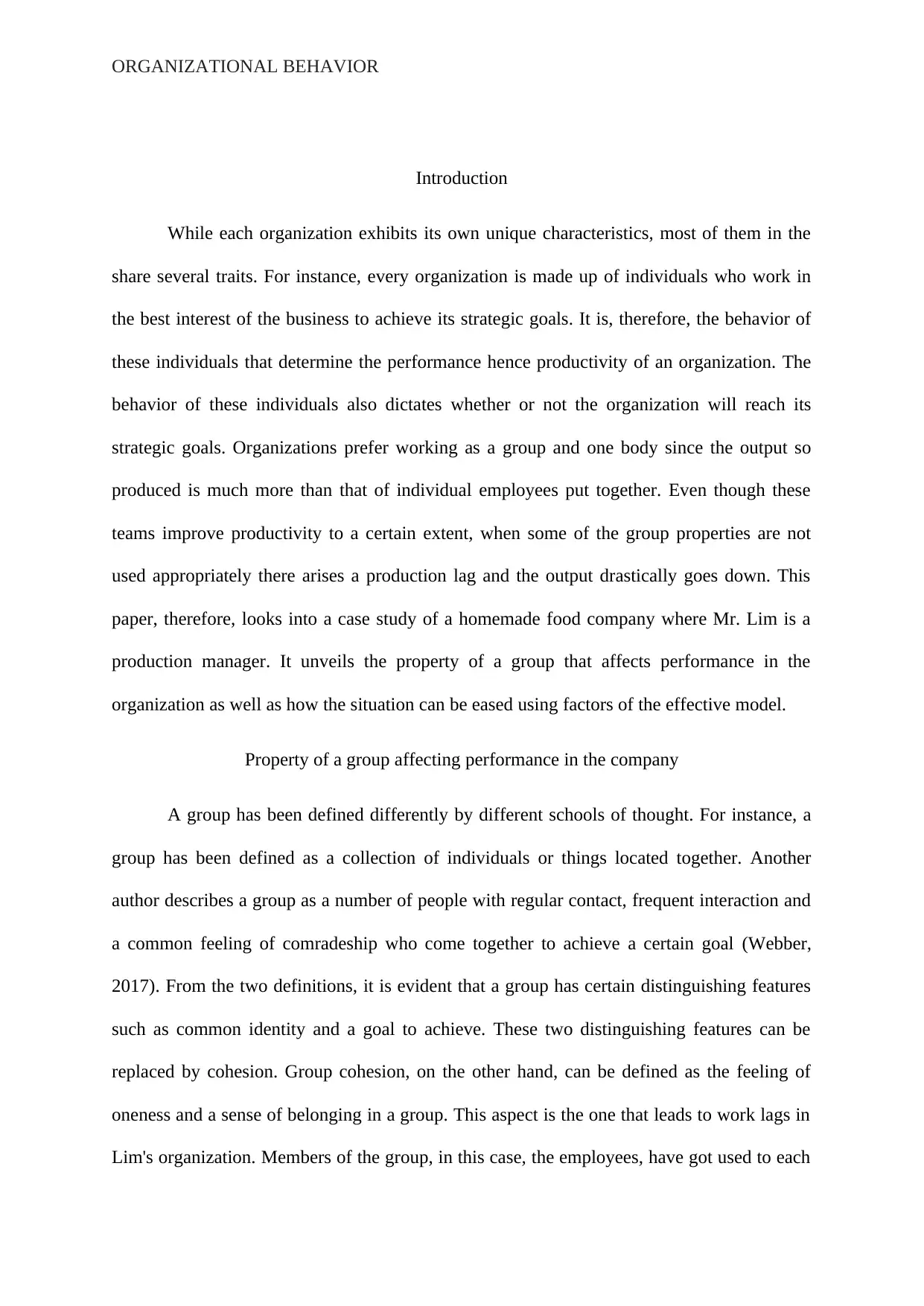
ORGANIZATIONAL BEHAVIOR
Introduction
While each organization exhibits its own unique characteristics, most of them in the
share several traits. For instance, every organization is made up of individuals who work in
the best interest of the business to achieve its strategic goals. It is, therefore, the behavior of
these individuals that determine the performance hence productivity of an organization. The
behavior of these individuals also dictates whether or not the organization will reach its
strategic goals. Organizations prefer working as a group and one body since the output so
produced is much more than that of individual employees put together. Even though these
teams improve productivity to a certain extent, when some of the group properties are not
used appropriately there arises a production lag and the output drastically goes down. This
paper, therefore, looks into a case study of a homemade food company where Mr. Lim is a
production manager. It unveils the property of a group that affects performance in the
organization as well as how the situation can be eased using factors of the effective model.
Property of a group affecting performance in the company
A group has been defined differently by different schools of thought. For instance, a
group has been defined as a collection of individuals or things located together. Another
author describes a group as a number of people with regular contact, frequent interaction and
a common feeling of comradeship who come together to achieve a certain goal (Webber,
2017). From the two definitions, it is evident that a group has certain distinguishing features
such as common identity and a goal to achieve. These two distinguishing features can be
replaced by cohesion. Group cohesion, on the other hand, can be defined as the feeling of
oneness and a sense of belonging in a group. This aspect is the one that leads to work lags in
Lim's organization. Members of the group, in this case, the employees, have got used to each
Introduction
While each organization exhibits its own unique characteristics, most of them in the
share several traits. For instance, every organization is made up of individuals who work in
the best interest of the business to achieve its strategic goals. It is, therefore, the behavior of
these individuals that determine the performance hence productivity of an organization. The
behavior of these individuals also dictates whether or not the organization will reach its
strategic goals. Organizations prefer working as a group and one body since the output so
produced is much more than that of individual employees put together. Even though these
teams improve productivity to a certain extent, when some of the group properties are not
used appropriately there arises a production lag and the output drastically goes down. This
paper, therefore, looks into a case study of a homemade food company where Mr. Lim is a
production manager. It unveils the property of a group that affects performance in the
organization as well as how the situation can be eased using factors of the effective model.
Property of a group affecting performance in the company
A group has been defined differently by different schools of thought. For instance, a
group has been defined as a collection of individuals or things located together. Another
author describes a group as a number of people with regular contact, frequent interaction and
a common feeling of comradeship who come together to achieve a certain goal (Webber,
2017). From the two definitions, it is evident that a group has certain distinguishing features
such as common identity and a goal to achieve. These two distinguishing features can be
replaced by cohesion. Group cohesion, on the other hand, can be defined as the feeling of
oneness and a sense of belonging in a group. This aspect is the one that leads to work lags in
Lim's organization. Members of the group, in this case, the employees, have got used to each
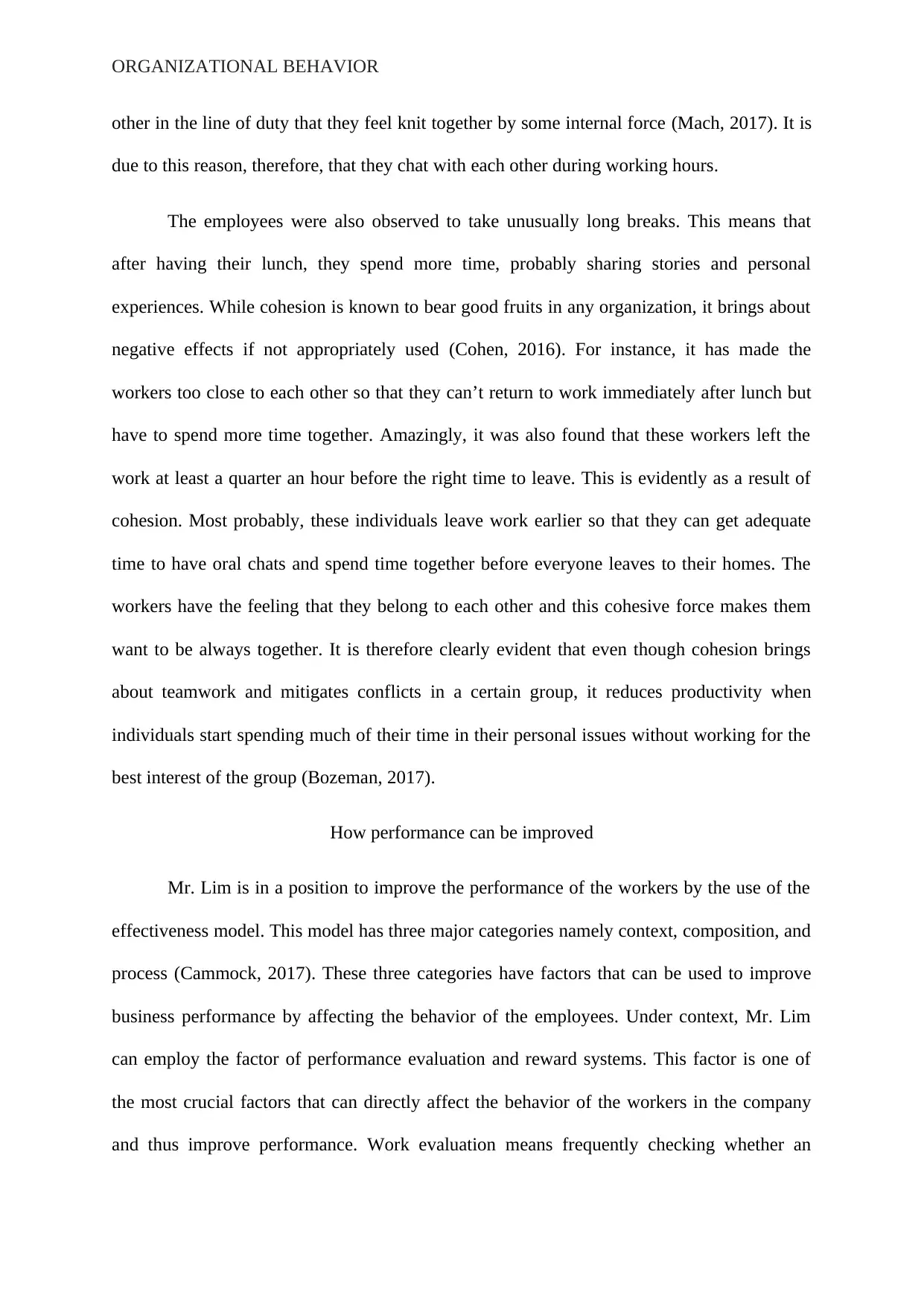
ORGANIZATIONAL BEHAVIOR
other in the line of duty that they feel knit together by some internal force (Mach, 2017). It is
due to this reason, therefore, that they chat with each other during working hours.
The employees were also observed to take unusually long breaks. This means that
after having their lunch, they spend more time, probably sharing stories and personal
experiences. While cohesion is known to bear good fruits in any organization, it brings about
negative effects if not appropriately used (Cohen, 2016). For instance, it has made the
workers too close to each other so that they can’t return to work immediately after lunch but
have to spend more time together. Amazingly, it was also found that these workers left the
work at least a quarter an hour before the right time to leave. This is evidently as a result of
cohesion. Most probably, these individuals leave work earlier so that they can get adequate
time to have oral chats and spend time together before everyone leaves to their homes. The
workers have the feeling that they belong to each other and this cohesive force makes them
want to be always together. It is therefore clearly evident that even though cohesion brings
about teamwork and mitigates conflicts in a certain group, it reduces productivity when
individuals start spending much of their time in their personal issues without working for the
best interest of the group (Bozeman, 2017).
How performance can be improved
Mr. Lim is in a position to improve the performance of the workers by the use of the
effectiveness model. This model has three major categories namely context, composition, and
process (Cammock, 2017). These three categories have factors that can be used to improve
business performance by affecting the behavior of the employees. Under context, Mr. Lim
can employ the factor of performance evaluation and reward systems. This factor is one of
the most crucial factors that can directly affect the behavior of the workers in the company
and thus improve performance. Work evaluation means frequently checking whether an
other in the line of duty that they feel knit together by some internal force (Mach, 2017). It is
due to this reason, therefore, that they chat with each other during working hours.
The employees were also observed to take unusually long breaks. This means that
after having their lunch, they spend more time, probably sharing stories and personal
experiences. While cohesion is known to bear good fruits in any organization, it brings about
negative effects if not appropriately used (Cohen, 2016). For instance, it has made the
workers too close to each other so that they can’t return to work immediately after lunch but
have to spend more time together. Amazingly, it was also found that these workers left the
work at least a quarter an hour before the right time to leave. This is evidently as a result of
cohesion. Most probably, these individuals leave work earlier so that they can get adequate
time to have oral chats and spend time together before everyone leaves to their homes. The
workers have the feeling that they belong to each other and this cohesive force makes them
want to be always together. It is therefore clearly evident that even though cohesion brings
about teamwork and mitigates conflicts in a certain group, it reduces productivity when
individuals start spending much of their time in their personal issues without working for the
best interest of the group (Bozeman, 2017).
How performance can be improved
Mr. Lim is in a position to improve the performance of the workers by the use of the
effectiveness model. This model has three major categories namely context, composition, and
process (Cammock, 2017). These three categories have factors that can be used to improve
business performance by affecting the behavior of the employees. Under context, Mr. Lim
can employ the factor of performance evaluation and reward systems. This factor is one of
the most crucial factors that can directly affect the behavior of the workers in the company
and thus improve performance. Work evaluation means frequently checking whether an
⊘ This is a preview!⊘
Do you want full access?
Subscribe today to unlock all pages.

Trusted by 1+ million students worldwide
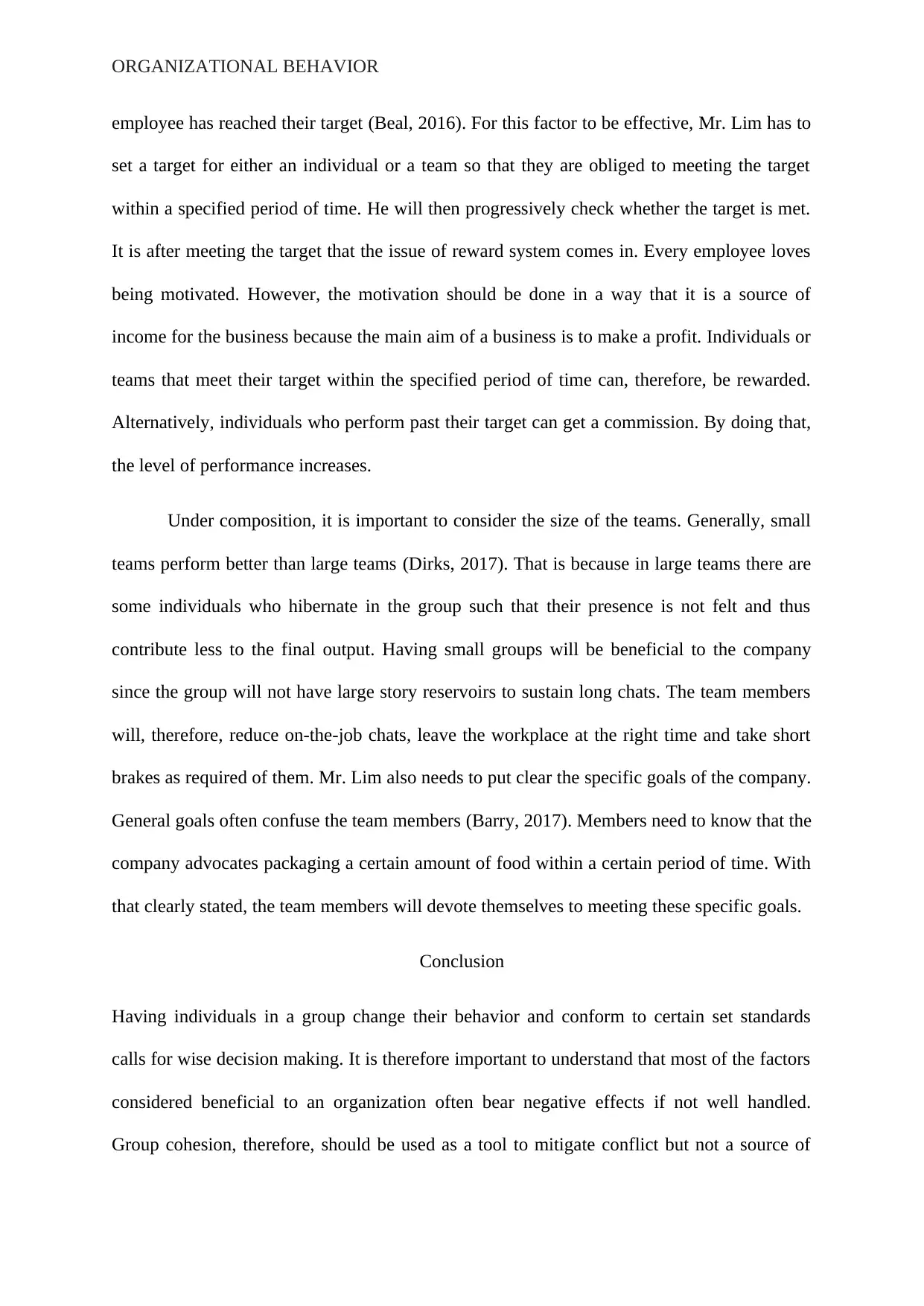
ORGANIZATIONAL BEHAVIOR
employee has reached their target (Beal, 2016). For this factor to be effective, Mr. Lim has to
set a target for either an individual or a team so that they are obliged to meeting the target
within a specified period of time. He will then progressively check whether the target is met.
It is after meeting the target that the issue of reward system comes in. Every employee loves
being motivated. However, the motivation should be done in a way that it is a source of
income for the business because the main aim of a business is to make a profit. Individuals or
teams that meet their target within the specified period of time can, therefore, be rewarded.
Alternatively, individuals who perform past their target can get a commission. By doing that,
the level of performance increases.
Under composition, it is important to consider the size of the teams. Generally, small
teams perform better than large teams (Dirks, 2017). That is because in large teams there are
some individuals who hibernate in the group such that their presence is not felt and thus
contribute less to the final output. Having small groups will be beneficial to the company
since the group will not have large story reservoirs to sustain long chats. The team members
will, therefore, reduce on-the-job chats, leave the workplace at the right time and take short
brakes as required of them. Mr. Lim also needs to put clear the specific goals of the company.
General goals often confuse the team members (Barry, 2017). Members need to know that the
company advocates packaging a certain amount of food within a certain period of time. With
that clearly stated, the team members will devote themselves to meeting these specific goals.
Conclusion
Having individuals in a group change their behavior and conform to certain set standards
calls for wise decision making. It is therefore important to understand that most of the factors
considered beneficial to an organization often bear negative effects if not well handled.
Group cohesion, therefore, should be used as a tool to mitigate conflict but not a source of
employee has reached their target (Beal, 2016). For this factor to be effective, Mr. Lim has to
set a target for either an individual or a team so that they are obliged to meeting the target
within a specified period of time. He will then progressively check whether the target is met.
It is after meeting the target that the issue of reward system comes in. Every employee loves
being motivated. However, the motivation should be done in a way that it is a source of
income for the business because the main aim of a business is to make a profit. Individuals or
teams that meet their target within the specified period of time can, therefore, be rewarded.
Alternatively, individuals who perform past their target can get a commission. By doing that,
the level of performance increases.
Under composition, it is important to consider the size of the teams. Generally, small
teams perform better than large teams (Dirks, 2017). That is because in large teams there are
some individuals who hibernate in the group such that their presence is not felt and thus
contribute less to the final output. Having small groups will be beneficial to the company
since the group will not have large story reservoirs to sustain long chats. The team members
will, therefore, reduce on-the-job chats, leave the workplace at the right time and take short
brakes as required of them. Mr. Lim also needs to put clear the specific goals of the company.
General goals often confuse the team members (Barry, 2017). Members need to know that the
company advocates packaging a certain amount of food within a certain period of time. With
that clearly stated, the team members will devote themselves to meeting these specific goals.
Conclusion
Having individuals in a group change their behavior and conform to certain set standards
calls for wise decision making. It is therefore important to understand that most of the factors
considered beneficial to an organization often bear negative effects if not well handled.
Group cohesion, therefore, should be used as a tool to mitigate conflict but not a source of
Paraphrase This Document
Need a fresh take? Get an instant paraphrase of this document with our AI Paraphraser
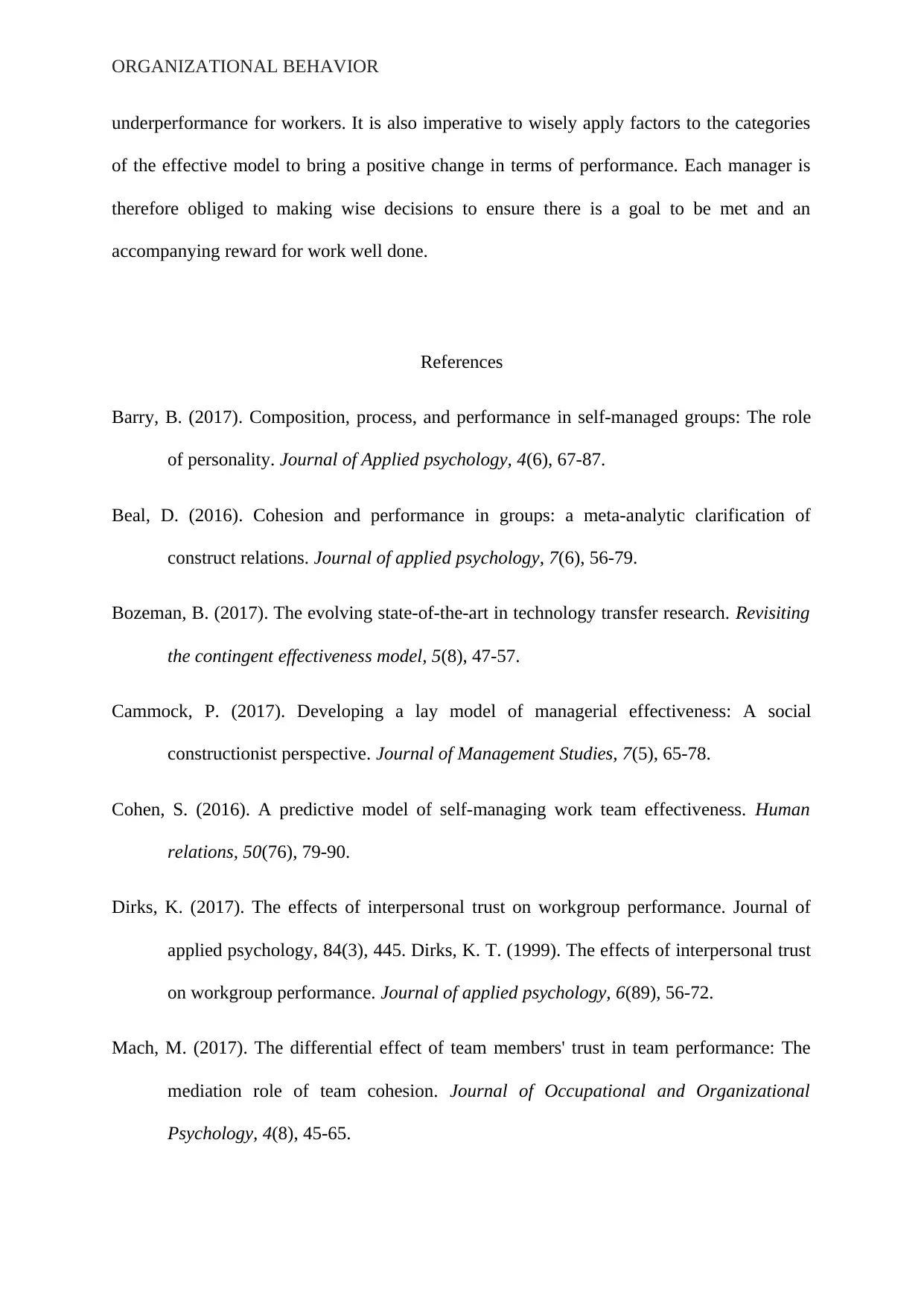
ORGANIZATIONAL BEHAVIOR
underperformance for workers. It is also imperative to wisely apply factors to the categories
of the effective model to bring a positive change in terms of performance. Each manager is
therefore obliged to making wise decisions to ensure there is a goal to be met and an
accompanying reward for work well done.
References
Barry, B. (2017). Composition, process, and performance in self-managed groups: The role
of personality. Journal of Applied psychology, 4(6), 67-87.
Beal, D. (2016). Cohesion and performance in groups: a meta-analytic clarification of
construct relations. Journal of applied psychology, 7(6), 56-79.
Bozeman, B. (2017). The evolving state-of-the-art in technology transfer research. Revisiting
the contingent effectiveness model, 5(8), 47-57.
Cammock, P. (2017). Developing a lay model of managerial effectiveness: A social
constructionist perspective. Journal of Management Studies, 7(5), 65-78.
Cohen, S. (2016). A predictive model of self-managing work team effectiveness. Human
relations, 50(76), 79-90.
Dirks, K. (2017). The effects of interpersonal trust on workgroup performance. Journal of
applied psychology, 84(3), 445. Dirks, K. T. (1999). The effects of interpersonal trust
on workgroup performance. Journal of applied psychology, 6(89), 56-72.
Mach, M. (2017). The differential effect of team members' trust in team performance: The
mediation role of team cohesion. Journal of Occupational and Organizational
Psychology, 4(8), 45-65.
underperformance for workers. It is also imperative to wisely apply factors to the categories
of the effective model to bring a positive change in terms of performance. Each manager is
therefore obliged to making wise decisions to ensure there is a goal to be met and an
accompanying reward for work well done.
References
Barry, B. (2017). Composition, process, and performance in self-managed groups: The role
of personality. Journal of Applied psychology, 4(6), 67-87.
Beal, D. (2016). Cohesion and performance in groups: a meta-analytic clarification of
construct relations. Journal of applied psychology, 7(6), 56-79.
Bozeman, B. (2017). The evolving state-of-the-art in technology transfer research. Revisiting
the contingent effectiveness model, 5(8), 47-57.
Cammock, P. (2017). Developing a lay model of managerial effectiveness: A social
constructionist perspective. Journal of Management Studies, 7(5), 65-78.
Cohen, S. (2016). A predictive model of self-managing work team effectiveness. Human
relations, 50(76), 79-90.
Dirks, K. (2017). The effects of interpersonal trust on workgroup performance. Journal of
applied psychology, 84(3), 445. Dirks, K. T. (1999). The effects of interpersonal trust
on workgroup performance. Journal of applied psychology, 6(89), 56-72.
Mach, M. (2017). The differential effect of team members' trust in team performance: The
mediation role of team cohesion. Journal of Occupational and Organizational
Psychology, 4(8), 45-65.
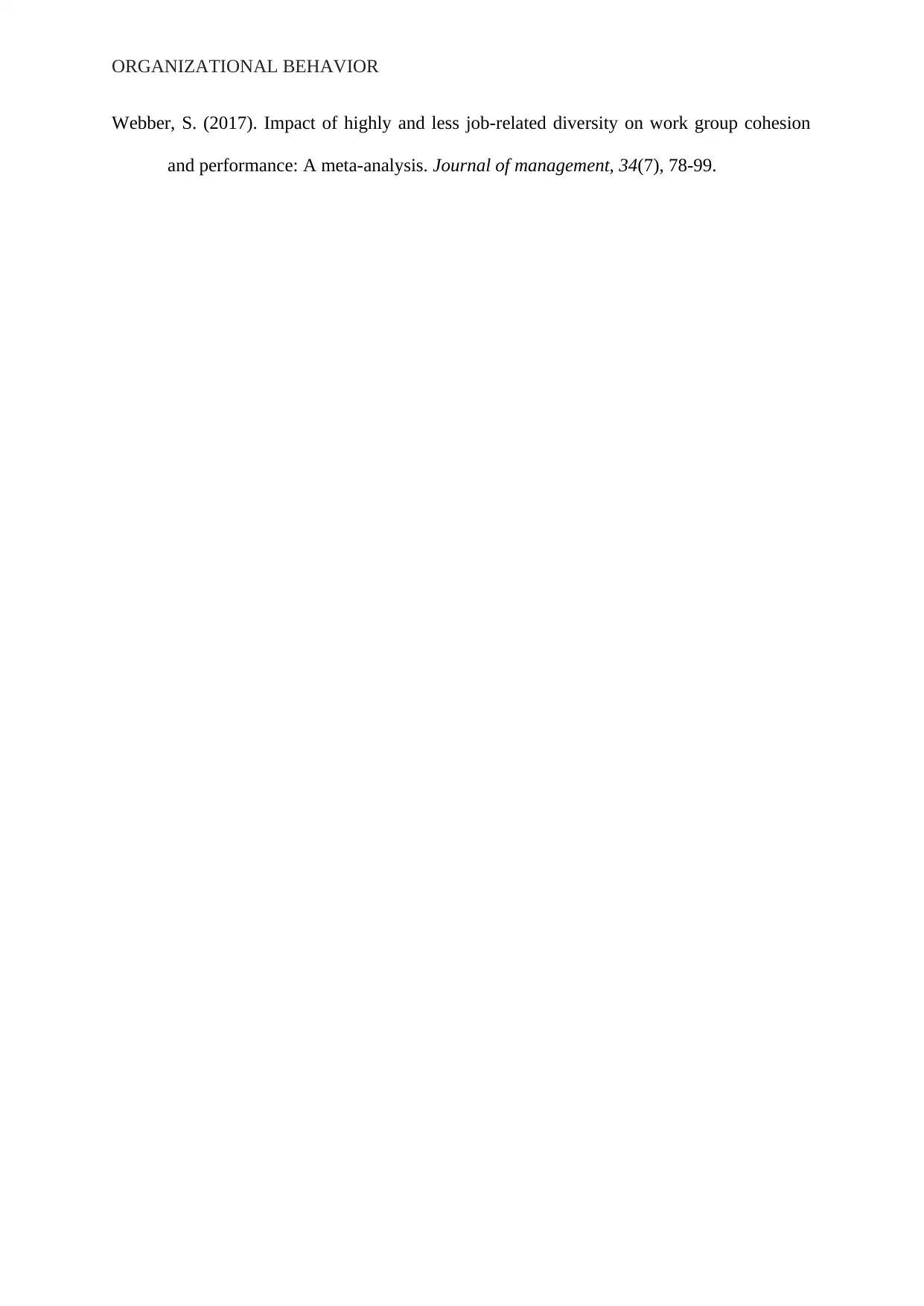
ORGANIZATIONAL BEHAVIOR
Webber, S. (2017). Impact of highly and less job-related diversity on work group cohesion
and performance: A meta-analysis. Journal of management, 34(7), 78-99.
Webber, S. (2017). Impact of highly and less job-related diversity on work group cohesion
and performance: A meta-analysis. Journal of management, 34(7), 78-99.
⊘ This is a preview!⊘
Do you want full access?
Subscribe today to unlock all pages.

Trusted by 1+ million students worldwide
1 out of 6
Related Documents
Your All-in-One AI-Powered Toolkit for Academic Success.
+13062052269
info@desklib.com
Available 24*7 on WhatsApp / Email
![[object Object]](/_next/static/media/star-bottom.7253800d.svg)
Unlock your academic potential
Copyright © 2020–2025 A2Z Services. All Rights Reserved. Developed and managed by ZUCOL.



